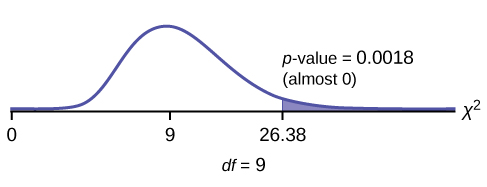

\(k =\) the number of different data cells or categories.The test statistic for a goodness-of-fit test is: The null and the alternative hypotheses for this test may be written in sentences or may be stated as equations or inequalities. You use a chi-square test (meaning the distribution for the hypothesis test is chi-square) to determine if there is a fit or not. Now, test 120 rolls of the die and enter.


If the die is fair then each side will have an equal probability of coming up if not, then one or more of the sides will come up more often. Let's say you want to know a six-sided die is fair or unfair (Advanced Statistics by Dr. For example, you may suspect your unknown data fit a binomial distribution. Las Vegas Dice Chi Square Goodness of Fit Test Example. The probability of a Type II Error can be calculated by clicking on the link at the bottom of the page.In this type of hypothesis test, you determine whether the data "fit" a particular distribution or not. These can be solved using the Two Population Calculator. Sometimes we're interest in hypothesis tests about two population means. The calculator on this page does hypothesis tests for one population mean. The observed values are the data values and the expected values are the values you would expect to get if the null hypothesis were true. where: O observed values (data) E expected values (from theory) k the number of different data cells or categories. Confidence intervals can be found using the Confidence Interval Calculator. The test statistic for a goodness-of-fit test is: (11.3.1) k ( O E) 2 E. If the hypothesized value of the population mean is outside of the confidence interval, we can reject the null hypothesis. Hypothesis testing is closely related to the statistical area of confidence intervals. Ideally, we'd like to reject the null hypothesis when the alternative hypothesis is true. A Type II Error is committed if you accept the null hypothesis when the alternative hypothesis is true. Ideally, we'd like to accept the null hypothesis when the null hypothesis is true. Chi-Square Test for Goodness of Fit More about the Chi-Square test for goodness of fit so that you can interpret in a better way the results delivered by this calculator: A Chi-Square for goodness of fit test is a test used to assess whether the observed data can be claimed to reasonably fit the expected data. In the first step we computed the expected values for red and black to be 47.368 and for green to be 5.263. 2 ( O b s e r v e d E x p e c t e d) 2 E x p e c t e d. A Type I Error is committed if you reject the null hypothesis when the null hypothesis is true. All expected counts are at least 5 so we can conduct a chi-square goodness of fit test. There are two types of errors you can make: Type I Error and Type II Error. When conducting a hypothesis test, there is always a chance that you come to the wrong conclusion. To switch from σ known to σ unknown, click on $\boxed$, reject $H_0$. Furthermore, if the population standard deviation σ is unknown, the sample standard deviation s is used instead. Use of the t distribution relies on the degrees of freedom, which is equal to the sample size minus one. If σ is unknown, our hypothesis test is known as a t test and we use the t distribution. If σ is known, our hypothesis test is known as a z test and we use the z distribution. The formula for the test statistic depends on whether the population standard deviation (σ) is known or unknown. The first step in hypothesis testing is to calculate the test statistic.


 0 kommentar(er)
0 kommentar(er)
